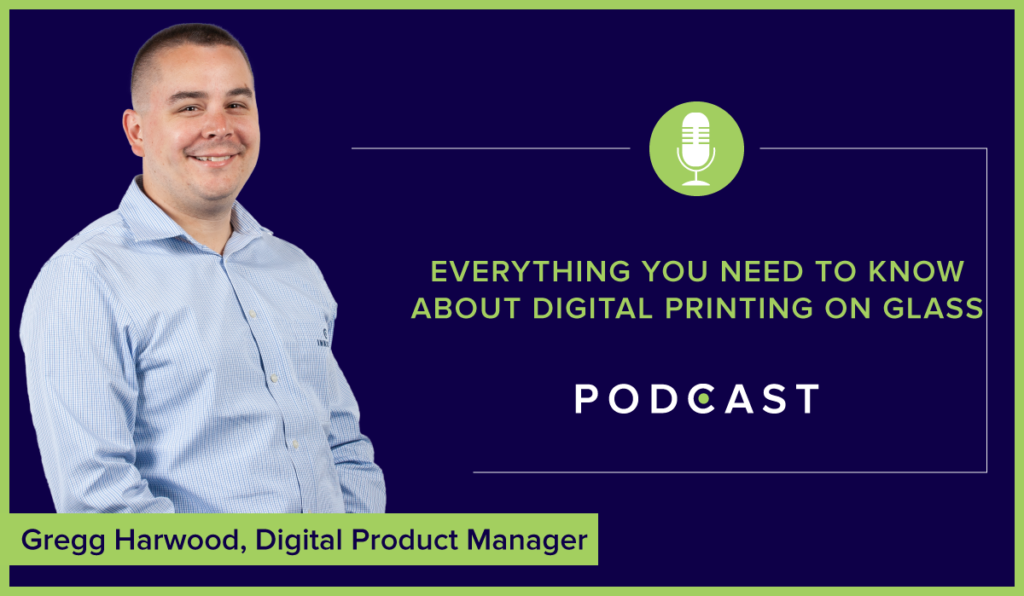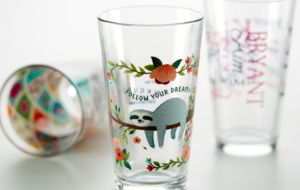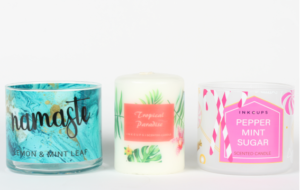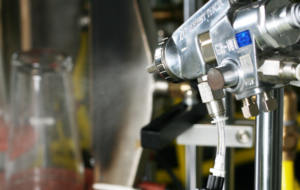
Gregg Harwood, digital product manager at Inkcups, a leading supplier and manufacturer of industrial inkjet printing equipment, discusses digital printing on glass.
John Maher: Hey, I’m John Maher. I’m here today with Gregg Harwood, digital product manager at Inkcups, a leading supplier and manufacturer of industrial inkjet printing equipment, pad printing equipment, inks and accessories. Today our topic is everything you need to know about digital printing on glass. Welcome Gregg.
Gregg Harwood: Thank you very much.
John: So Gregg, why is glass sets such a tough substrate to print on?
Gregg: Glass is different. Glass has a polyester coating on most pieces of glassware, especially the drinkware. you can’t really get ink to stick to it. So there’s pre-treatment methods that we take in order to get that ink adhesion on that product. So the polyester is designed so that it prevents scuffing from glass to glass, but it kind of… it’s a detriment when it comes to the ink adhesion standpoint. So you’ve got to get rid of it. So that’s the biggest takeaway.
And then as far as some of the adhesion requirements on glass, especially depending on the market that you’re selling to, the durability requirements are pretty stringent. 500 dishwashes, adhesion cross-hatching. The demand is much higher for good bond to that ink.
John: Okay. So we’ll talk a little bit more about adhesion in a minute. But what are some examples of different products that are made of glass that can be digitally printed?
Gregg: Drinkware is, obviously, the first thing that comes to mind, different drink where vessels, pint glasses, your normal 16 ounce mixing glass, stemmed wine glasses, stemless wine glasses, rocks glasses, anything you can kind of drink out of that’s somewhat got, whether it’s a taper or whether it’s a straight wall type of cylinder. Beyond drinkware, you can print on Christmas ornaments. Awards, that’s a big market, printing on awards. Either they engrave them or they can digitally print on them. Obviously, depending on where you’re selling the end product, the durability changes. So the need for the pre-treatment side can change. It might not be as drastic.

John: Anything with phones? I know some mobile phones have sort of glass components to them or any other sort of flat products that maybe that would be made of glass.
Gregg: Certainly it would work or we haven’t really done much applications like that. I would say you know 90% of the glass we do is drinkware. But certainly anything flat really our products in our pre-treatment, our application specialty can work with anything flat really.

John: Right. And then in terms of the drinkware, obviously, those are cylindrical or even not tapered, things like that. So you have some ways around that and we can get into that, but talk… go back to the adhesion issues and talk a little bit more about glass and how it is that you work with the issues that glass has in terms of adhesion.
Gregg: For glass, I mean, we learned kind of a long time ago that you have to burn off that polyester and I mean there’s some trade secret too, obviously, that we don’t want to divulge too much but you have to burn that off. And then we created a water based priming spray that will essentially coat that glass, the whole glass. It shouldn’t be visible to the consumer, but it works as a bonding agent for that ink. It’s water base. There are no VOCs. It’s very safe to use and we developed a system to spray it. So the system that we developed, the MagiCoat Pre-treatment System, it’ll not only flame the glass to the correct temperature and burn off that polyester, it will also spray that item as well. Kind of all in one rotation, one index of that turret, so that it’ll spit out about 15 items per minute. So it’s a very fast pre-treatment method for high volume glass users.And below that we have a manual process too. That’s a small percentage of that price, but it will do the same thing, but it requires you a little bit more manual process.
John: Okay. In terms of pre-treating the glass so that the ink will adhere to the glass?
Gregg: Yeah. Same spray, same chemical, just the application, rather it be labor, spraying it manually, it will actually do it automated.

John: Okay. Talk a little bit about some of the digital printing methods or even the different types of digital printers that are available to print on glass.
Gregg: Our software lends itself nicely for kind of a trademarked decorating method called a mirror print. It’s essentially sandwich mode. So it’s going to lay down color then white in the middle and color on top. So it compares to your traditional screen printing, because it’s different than that I should say, because if you look at a traditional screen printed glass, it has a white backing, which is not very visibly pleasing. So instead the mirror print is a mode that you can enable on the drinkware printers that lay down color, white, color, so now you’re seeing color from both sides, whether the side you’re drinking from or if you’re looking at somebody drinking a glass you’re seeing the same imprint. So that’s one kind of unique decorating method that we offer.
John: So you need that white in the middle there in order for the color to not be transparent and see right through it?
Gregg: Yeah. If you don’t do that, it ends up being like a stained glass look which some people like that as well. Other decorating methods on that, I mean we’ve done textured ink so we’ve stacked the ink, so it kind of gives like a braille type of feel. We’ve done clear only and clear only gives it like an embossed look so you can run your finger across it and it’s raised. It looks as though when you’re making the glass it’s part of the mold. And that’s been pretty popular.
Beyond, and I didn’t even mention this before, but beyond mixing glasses and all your drinkware you got the whole spirit bottle market too, that… anything, whether it be beer growlers or spirit bottles, vodka, tequila, scotch, we’ve sold into those markets as well.
Brings me to the point where most digital printers require the use of a UV blocking agent. So because of the way that the drinkware printers work, ours included, your print heads reside atop the UV lamp. So obviously, the UV lamp will cure the ink. So if you have ink on the bottom of the head as you’re trying to spray, it’ll cure your heads. So because it’s a transparent product, if you don’t have anything filling that, the light just bounces right up to the heads and it’s kind of game over, your heads are fried.
John: They would clog the heads up.
Gregg: Yeah.
John: Because you could basically be curing or hardening the ink on the head and then it’s not going to spray anymore.
Gregg: Right. So I mean our machines are smart enough where they have some safeties there that they won’t let you do it. However, if they don’t let you do it, you can’t print it. So it’s kind
of a double edged sword. But what we’ve developed over the past six months or eight months or so is the ability to not stuff it. So no more beads to… for spirit bottles, you have to fill it with beads or some sort of blocking agent, whatever it is. It has to just be something dark.
John: Something to keep that… something to keep that UV light from going through that print heads, right?
Gregg: Yeah. It’s not a huge bottleneck, but it’s a big enough labor clog that it made us develop something that can eliminate that. So we did that. It’s called the transparent vessel curing system and now on a Helix®, for right now it’s only on the Helix®, you can actually load your product without it being filled with anything. The light’s below and it’s going to run down the tunnel and print, come back out post-cure out of the tunnel. No harm to your print heads. Good stability, good longevity of those heads. There’s no difference. So that’s been a huge development that we recently launched.
John: In terms of digital printing on glass, obviously, like you said, the majority of the things that you’re printing on our drinkware, which are cylindrical, they could have tapered shapes to them, like a pint glass where it’s narrower on the bottom, wider at the top, different odd shapes like the spirit bottles that you’re talking about. What kinds of machines do you have that can deal with cylinder printing or oddly shaped products.
Update: As of October 2022 the X360 has been discontinued. Please see our full line up of current printers here.
Gregg: So Inkcups offers three. We have three models in our drinkware machine suite on the X360. The X360 produces maybe about one to two pieces a minute. The Helix®, which is the middle tier, does about four to five per minute. And then the Revolution®, which is brand new, launched last year late, about a 600 parts per hour machine. So it’s depending on volume.
Helix® Digital Cylinder Printer
Revolution® High-Speed Digital Cylinder Printer
All the machines are very good… they’re quick changeover machines. Even the Revolution® which has 12 mandrels and we’ll run it as like a turret style, 12 pieces on this big dial and it just indexes and goes from station to station, automatic in-feed, automatic out-feed. Even that machine, all in all, 12 mandrels and everything’s going to take about 15 to 20 minutes to change over from one skew to the next. On the Helix®, you’re probably under three minutes to change over. The X360’s about the same. So that’s kind of where all of our equipment is. It’s a quick change over, short run, thinking that your customer is going to be trying different… during the course of the day, they’re doing a number of different skews, so that’s where our equipment really thrives.
John: Right? So the customer will need to come to you if they’re interested in a piece of equipment like that, likeone of these digital printers for glass. They should talk to you about all
of the different, okay, We have this number of different products that we tend to print on. We do short runs versus long runs, but what are some of the things that they should be talking to you about in terms of their needs that will help you to determine which type of product is the right one for them?
Gregg: Yeah, good question. I mean obviously right off the bat it’s how much do they have budgeted for this piece of equipment, because that’s going to lean us one way or the other. I mean, the three machines are very different in price, very different in throughput. Sometimes it makes sense to buy two of the lower end machines instead of one in the middle. And for redundancy reasons,some people are very… that comes out in the conversation where redundancy is important.
John: If something happens to one machine they want to make sure that there is another.
Gregg: Yeah, that they have another one that they can run. So all of that is early on in the sales cycle where you’re asking questions about speed. Obviously, if they come out and they say, “Yeah, I need to print 1,000 pieces an hour.” Okay, then you’re looking at a Revolution® and you’re looking at probably two. Typically, we can tell a lot just by that number, what’s your expected volume per hour. If they’re comparing it to screen printing, you know there’s a discussion there. What are the limitations of digital printing? Where it would make sense to go digital, where it doesn’t make sense to go digital. I mean if their normal job size is 5,000 and up, it doesn’t make sense to go digital, but it makes sense to stick with screen printing unless they have a burning need to go multi color. If they’re one color to color and that’s all they’re doing, screen printing at that type of volume, that’s right there, in the beginning you’d say, “Yeah, it doesn’t make sense.”
But when they’re getting into the smaller runs and the necessity for multi color, which a lot of people are faced with now, where everyone wants to offer multi color full color-
John: Sure. You see that, like you said, on spirit bottles, beer cans, other glassware.
Gregg: They want that vibrancy-
John: Things like that. Yeah.
Gregg: … as a brand and they want that vibrancy to jump off the shelf. So when they need that, then by all means they got to go digital. I mean, lining up a six color screen printer or a six color pad printer, it’s a nightmare. It takes time. So if you’re doing it for a 10,000 piece run, makes sense. If you’re doing it for 200 pieces, it doesn’t make sense at all. So that’s where really, our niche is in that market.
John: Yeah, that’s really great information, Gregg, and thanks again for speaking with me today.
Gregg: No problem. Thanks for having me.
John: And for more information about Inkcups and Inkcups’ printing equipment, visit the website at www.inkcups.com or call 978-646-8980.
Back to Blog Home
Add Your Comment